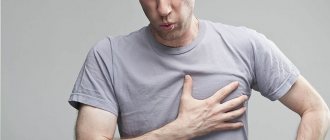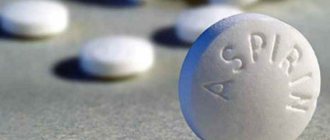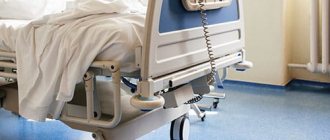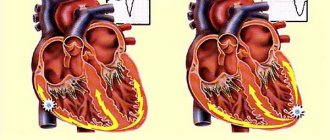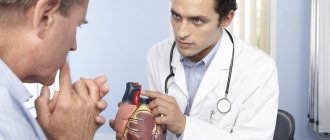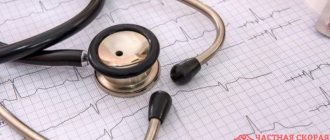Arrhythmia is a violation of cardiac conduction, in which there is a change in the frequency, rhythm and regularity of contractions of the heart muscle. The heart may beat faster or, conversely, slower, or simply irregular.
Arrhythmia can be provoked by:
- disturbances in the formation of an electrical impulse in the sinus node (sinus tachycardia, bradycardia);
- violations of intracardiac impulse conduction. Occur as a result of a decrease or cessation of impulse transmission through the conduction system (blockade, premature excitation of the ventricles of the heart);
- combined rhythm disturbances. Combine disturbances in the conduction of electrical impulses and heartbeat rhythm.
What is arrhythmia?
The heart works like a pump and ensures continuous blood circulation.
This is necessary to deliver blood enriched with oxygen and nutrients to every cell of the body. In the right atrium of the heart there is the sinus node (SU), the “commander-in-chief” of the heart rhythm. The sinus node generates electrical impulses, under the influence of which the right and left atria first contract, then the right and left ventricles. Other parts of the myocardium can also generate electrical impulses, but in a healthy heart they are suppressed by the sinus node and do not disturb the heart rhythm.
The correct heart rhythm is considered to be sinus rhythm, in which the heart rate (heart rate) is from 60 to 80 beats/min. An arrhythmia is any heart rhythm that differs from normal sinus rhythm.
Heart rate is determined in a state of physical and emotional rest, since this indicator may increase during sports or excitement. It should also be noted that the normal heart rate is a relative value and depends on the individual characteristics of a person. For example, a rapid heart rate can be observed during pregnancy, a slow heart rate in athletes.
Causes of arrhythmia
The most common causes of arrhythmia or the condition leading to its development are heart disease, high blood pressure, diabetes, smoking, excessive consumption of alcohol and caffeine, drug abuse, and stress. In some cases, the causes of arrhythmias may be an overdose of certain medications, the use of dietary supplements and herbal preparations.
Scars can occur for various reasons. The most common of these is acute myocardial infarction. Such a scar prevents the formation of an electrical impulse and/or interrupts the passage of an impulse through the heart muscle.
In a healthy person with a healthy heart, the development of a stable arrhythmia is impossible without the presence of an external trigger, such as an electric shock. This happens primarily because in a healthy heart there are no pathological substrates for the development of arrhythmias, including scar tissue.
On the other hand, in hearts with signs of arrhythmia, the formation and/or propagation of the electrical impulse may be impaired, facilitating the development of the disease.
Any of the following conditions can lead to the development of arrhythmia:
○ Inadequate blood supply
. If blood flow to the heart is reduced for any reason, this can alter the cells' ability to form and conduct electrical impulses.
○ Damage or death of the heart muscle
. Damage or death of the heart muscle leads to a change in the path of electrical impulses propagating through it.
Among the heart disease causes of arrhythmias, the following are of particular importance:
○
Coronary heart disease (CHD)
. Despite the fact that many types of arrhythmias are recorded with ischemic heart disease, the most strongly associated with it are ventricular arrhythmias and sudden cardiac death. The narrowing of the arteries occurs until, as a result of lack of blood supply, part of the heart muscle dies (acute myocardial infarction). This can affect the process of propagation of an electrical impulse throughout the myocardium: small electrical circles of excitation are formed at the border of scar tissue, which disrupt the normal functioning of the heart, causing pathologically fast heartbeat (ventricular tachycardia) and ventricular flutter or fibrillation - ineffective chaotic contractions of the ventricles.
○ Cardiomyopathy
. It manifests itself as primary stretching and thinning of the walls of the ventricles and atria (dilated cardiomyopathy) or excessive thickening and overcontraction of the walls of the left ventricle (hypertrophic cardiomyopathy). With any variant of cardiomyopathy, the efficiency of cardiac output decreases (the amount of blood ejected by the left ventricle into the aorta to nourish all organs and tissues of the body decreases), and part of the blood remains in the left and right ventricles or is thrown back into the atria and the veins flowing into them.
Heart valve diseases. Damage to the heart valves by infectious agents or due to degenerative degeneration leads to narrowing of the valve openings and/or insufficient closure of the valves, i.e. valve insufficiency. When the chambers of the heart become stretched and weakened due to inadequate valve function, the risk of developing various types of heart rhythm disorders increases.
Types of arrhythmia
There are several options for classifying arrhythmias. Depending on the heart rate there are:
- tachycardia (heart rate exceeds 90 beats/min);
- bradycardia (heart rate less than 60 beats/min).
The main classification of arrhythmias is based on what physiological property of the myocardium is impaired - automaticity, excitability, conductivity.
- Violation of myocardial automatism.
Automaticity is the ability of the heart to contract rhythmically without external stimulation under the influence of impulses arising within itself.
Arrhythmias in which the automaticity of the heart is impaired and the sinus node acts as the driver of the heart rhythm are called “nomotopic.” For example, such arrhythmias include sinus tachycardia, sinus bradycardia, and sinus node syndrome. Often nomotopic arrhythmias are diagnosed in absolutely healthy people and are physiological.
Arrhythmias in which the automaticity of the heart is impaired and the pacemaker is located outside the sinus node are called “ectopic” or “heterotopic”. With ectopic arrhythmias, the center of automatism moves to the sections underlying the SG with the formation of abnormal rhythms. Ectopic arrhythmias include:
- atrioventricular rhythm - the pacemaker is the AV node (atrioventricular node);
- migration of the supraventricular pacemaker - gradual displacement of the pacemaker from the sinus node to the AV node;
- idioventricular rhythm - ventricular rhythm.
- Impaired cardiac excitability.
Cardiac excitability is the ability of the myocardium to be excited under the influence of external influences.
Arrhythmias in which the excitability of the heart is impaired include:
- extrasystoles - the appearance of extraordinary contractions of the entire heart or its individual chambers. Depending on the location of the extrasystoles, there are sinus, atrial, nodal, ventricular;
- paroxysmal tachycardia - heart rhythm disturbances, which are characterized by palpitations with a heart rate of 140-220 beats/min. The most common form of this type of arrhythmia is atrial. Less common are atrioventricular and ventricular paroxysmal tachycardias.
- Impaired cardiac conduction.
Conductivity is the ability of the heart to conduct electrical impulses from the point of their origin to the contractile part of the myocardium. If cardiac conduction is impaired, various blockades may occur:
- SA blockade is a violation of myocardial conduction between the sinus node and the atrium;
- interatrial blockade - slow passage of impulses between the atria;
- AV block - arrhythmias in which the transmission of impulses from the atria to the ventricles slows down;
- intraventricular blockade - disruption of the conduction of the His bundle.
Also, arrhythmias in which cardiac conduction is disrupted include Wolff-Parkinson-White syndrome, a congenital heart pathology characterized by the presence of additional conduction pathways, which leads to premature excitation of the ventricles.
- Mixed arrhythmias.
With mixed arrhythmias, several physiological properties of the heart are disrupted. For example, such arrhythmias include ectopic rhythms with exit block and atrioventricular dissociations. One of the most common mixed arrhythmias is atrial fibrillation, in which chaotic electrical activity of the atria is observed with a pulse frequency of 350-700 beats per minute.
Cardiovascular disease and erectile dysfunction
The term "erectile dysfunction" was proposed by the US National Institutes of Health instead of "impotence." In 1992, it was adopted by international organizations of urologists and andrologists. In a broad sense, erectile dysfunction includes not only the inability to keep the penis erect, but also disturbances in orgasm, as well as a weakening of libido - sexual desire. Due to the increase in life expectancy and the formation of a socially active behavior pattern even in old age, erectile dysfunction (ED) in men becomes important, and an erection is perceived as a symbol of power, a symbol of masculinity. ED is also important for the doctor, since erection is a vascular reaction and its disturbances may reflect the presence of cardiovascular pathology in the patient.
According to the Consensus Commission of the US National Institutes of Health, at least 30 million men in this country suffer from erectile dysfunction (Nffl Consensus Develohincnt Panel on Impotence/. Amer. Med. Assoc. - 1993. Vol. 270, No. 1.- P. 83 -90). In the Massachusetts Study of Male Aging (Feldman N.L. at al., 1994). A survey was conducted of 1,709 men aged 40 to 70 years. The results of the study demonstrated the following patterns: erectile dysfunction was observed in 39% of people aged 40 years, it was observed in 48% of men aged 50 years, in 60-year-olds, erectile dysfunction occurred in 57%, and in 70-year-olds - in 67% of cases . Thus, the tendency towards the progression of erectile dysfunction intensified with increasing life expectancy of those observed, i.e., it increased with each new decade. Increasing life expectancy and the formation of a socially active behavior pattern even in old age leads to the fact that erectile dysfunction (ED) in men becomes important, and an erection is perceived as a symbol of wealth, health, and a symbol of masculinity. The results of special prospective observations (Duke longitudinal study, Swedish study, Caerphilly cohort study) indicate that men with a relatively low frequency of sexual intercourse and orgasm, as well as those who lost sexual activity early, have an increased risk of death.
The occurrence of ED dysfunction in a patient is also important for the doctor, since erection is a vascular reaction and its disturbances may reflect the presence of cardiovascular pathology in the patient. It was once believed that most cases of ED were psychogenic in nature. But studies that have clarified the true mechanism of erection have shown that in patients over 40 years of age, ED in 80% of cases occurs as a complication of various somatic diseases (Shcheplev P.A. et al., 2002). The presence of a close correlation with micro- and macroangiopathies is absolute proof that ED is an obligate risk factor for cardiovascular diseases. The presence of erectile dysfunction is often associated with one or more cardiovascular diseases (arterial hypertension, atherosclerosis) and diabetes mellitus (Feldman HA et al., 1994). Damage to the blood vessels of the penis prevents the erection necessary for sexual intercourse. According to some authors, the detection of ED may indicate the presence of a latent form of diabetes, hypertension and coronary heart disease (CHD) in the patient, which allows us to consider overt ED as a likely predictor of latent vascular damage to the heart and arterial hypertension, since the diameter of the arteries supplying the penis much smaller than the diameter of the coronary arteries and therefore ED can serve as an early harbinger of cardiovascular diseases, and the progression of coronary artery disease can be judged by the degree of its severity.
With atherosclerosis, the walls of blood vessels lose their elasticity and narrow due to atherosclerotic plaques, which leads to the development of heart attacks and strokes. Due to atherosclerotic vascular damage, not only a mechanical disturbance of blood flow occurs, but also the production of neurotransmitters is disrupted, and the elasticity of blood vessels decreases. Endothelial dysfunction and insufficient production of nitric oxide are the most important pathogenetic link in both hypertension and vasculogenic ED. Developing remodeling with decreased elasticity and a decrease in the lumen of blood vessels that provide blood flow during erection leads to the development of vasculogenic ED. Often, various manifestations of atherosclerosis (IHD and erectile dysfunction) develop in parallel, since the risk factors for endothelial dysfunction and atherosclerosis affecting the penile blood vessels are the same as the risk factors for IHD - smoking, dyslipilemia, diabetes mellitus. The risk of coronary artery disease in patients over the age of 50 years is significantly increased in the presence of erectile dysfunction (Speei et al., 2003).
Arterial hypertension also contributes to the occurrence of erectile dysfunction, even in the absence of atherosclerosis. International experimental studies on arterial hypertension and erectile dysfunction have shown that hypertension promotes the proliferation of muscle tissue in the corpora cavernosa and blood vessels, causes fibrosis of the cavernous tissue and increases the amount of type III collagen in it. Moreover, the severity of these changes is directly proportional to the degree of increase in systolic blood pressure.
Taking medications and inadequate antihypertensive therapy can be the cause of erectile dysfunction in 25% of cases according to data (O'Keefe et al., 1995). Clinical signs of drug-induced erectile dysfunction are considered to be a relatively rapid onset, a temporary connection with taking a drug that negatively affects various parts of sexual intercourse, a decrease in the severity of the disorder or its complete disappearance after discontinuation of the drug. Very often, the occurrence of erectile dysfunction is associated with taking antihypertensive drugs, especially thiazide diuretics and beta-blockers, especially the first generations. It has been suggested that erectile dysfunction may result from decreased blood flow to the penis, but it is unclear whether this decrease is a consequence of decreased systemic blood pressure with effective antihypertensive therapy, a result of vascular disease, or some other unknown drug effect. If a decrease in blood pressure in itself contributed to the development of erectile dysfunction, then it would develop against the background of any antihypertensive therapy. It has been proven, however, that many antihypertensive drugs do not cause erectile dysfunction. The use of angiotensin receptor blockers significantly reduces changes in cavernous tissue; there is even a tendency to increase sexual activity in men and a statistically significant increase in sexual satisfaction. It is also believed that calcium antagonists do not impair male sexual function. In many cases, changing the medication regimen can help the patient overcome the negative changes in sexual behavior that are observed with some types of treatment. It is advisable to choose an antihypertensive treatment that not only reduces blood pressure, but also maintains quality of life.
The practitioner should remember the possibility of the influence of antihypertensive therapy on the male genital area and discuss this topic with his patients. Not only among patients but also among doctors, there is a widespread belief that there is a high risk of sudden death in patients with cardiovascular diseases during sexual intercourse, however, as a number of studies have shown, these fears are significantly exaggerated. Physical activity during sexual activity is not that great - on average it is similar to walking 1.6 km in 20 minutes or climbing 2 flights of stairs (20 steps) in 10 seconds. During sexual intercourse, a man's maximum heart rate (HR) reaches an average of 120–130 beats/min, while systolic blood pressure (SBP) rises to 150–180 mmHg. Art. However, these indicators take place within only 3–5 minutes with an average duration of sexual intercourse of 5–15 minutes. In a study by JE Muller et al. (1996) found that the relative risk of developing MI during sexual intercourse and in the next 2 hours is 2.5 times higher, and in patients who have previously suffered an MI, it is almost 3 times higher than during other activities. The calculations of these researchers show that in a practically healthy (without obvious coronary heart disease (CHD)) 50-year-old man, the probability of developing an MI during sexual intercourse is 1% over the course of a year, or 1 in a million chance over the course of an hour. If such a man has intercourse once a week, then the risk of developing MI during intercourse or in the next 2 hours increases to only 1.01% per year (2-3 chances per million per hour). However, in a man of the same age who is equally active sexually but has already had an MI, the initial risk of developing a second MI is approximately 10% per year, and during sexual activity and in the next 2 hours the risk increases to 10.1%. those. it increases from 10 to 20–30 chances per million per hour. According to other data, the risk of MI after sexual activity in a patient with isolated cardiovascular disease (CVD) increases to ~30 cases per million/hour within 2 hours after coitus. One 25-year US study of 270 men and women aged 60-94 years (mean 70) at baseline found that frequency of sexual intercourse correlated with men's life expectancy. At the same time, a Swedish study of 128 married men aged 70 years who were followed for 5 years showed that early cessation of sexual activity (before age 70) was associated with an increased risk of death compared with the group who continued to be sexually active. .
Thus, it can be stated that sexual life should be and is an important component of the quality of life of patients with cardiovascular diseases. Compliance with a multidisciplinary approach in the management of this category of patients is the key to effective treatment of patients with cardiovascular pathology while maintaining a high quality of life.
Causes of heart rhythm disturbances
As a rule, arrhythmia is not the main pathology, but a consequence of other diseases. Causes of heart rhythm disturbances may include:
- sleep apnea syndrome is a disorder of the respiratory system, which is accompanied by temporary cessation of breathing at night, followed by the release of adrenaline and an increase in heart rate;
- arterial hypertension - syndrome of high blood pressure;
- coronary heart disease - a discrepancy between the myocardial need for oxygen and its delivery;
- heart failure - weakening of the pumping function of the heart;
- congenital and acquired heart defects.
- cardiomyopathies - pathologies of the myocardium associated with its mechanical or electrical dysfunction;
- myocarditis - inflammation of the heart muscle;
- myocardial surgery;
- previous heart attack;
- hyperthyroidism - hyperfunction of the thyroid gland;
- lung diseases;
- diabetes;
- infections.
There are arrhythmias that are based on genetic pathologies. For example, the arrhythmia can be caused by congenital long QT syndrome, which leads to ventricular tachycardia.
Risk factors for arrhythmia include:
- physical inactivity or, conversely, excessive physical activity;
- obesity;
- smoking, alcohol abuse;
- chronic lack of sleep;
- hormonal changes in the body. For example, in women, arrhythmia is often diagnosed after the onset of menopause;
- uncontrolled use of drugs that have an arrhythmogenic effect.
Treatment of the disease
It is necessary to distinguish between the treatment of heart failure occurring in acute and chronic form.
Treatment of acute heart failure. This disease begins sharply and suddenly. It grows quickly and then turns into an attack of suffocation. There is a severe cough with expectoration of foamy contents and other symptoms of pulmonary edema or cardiac asthma. Therefore, treatment of heart failure begins with calling a doctor and providing first aid. The patient is admitted to the hospital, where he is under strict supervision. The cardiologist, in accordance with the patient’s condition, prescribes an appropriate course of treatment.
Treatment of chronic heart failure. It is usually carried out at home. The process begins with treating the disease that caused the syndrome to develop. It is important to maintain psycho-emotional peace and engage in physical therapy in a medical institution (only under the supervision of a specialist with appropriate education).
A diet must be prescribed, limiting fluid intake to 1,200 ml and salt to 4 g (sometimes to 1-2 g per day). Food should be high in proteins, minerals and vitamins. Consumption of carbohydrates and fried foods is necessary to reduce the risk of obesity. Patients with heart failure are prohibited from eating spicy foods.
If edema is present, diuretics are prescribed. Sometimes they are combined with drugs containing potassium. During the period of use, you need to monitor the results of a blood test to determine the level of uric acid, potassium, sodium and monitor the acid-base balance.
Surgical methods for treating heart failure. Such treatment methods include:
- coronary artery bypass grafting;
- operations on heart valves, which lead to a decrease in the load on the myocardium;
- heart transplantation.
How does arrhythmia manifest?
Arrhythmia may be accompanied by the following symptoms:
- a feeling of interruptions in the work of the heart;
- a feeling of somersault, a jolt in the heart;
- accelerated heartbeat;
- suffocation;
- dizziness;
- general weakness, fatigue;
- exercise intolerance.
The most severe manifestations of arrhythmia are presyncope and loss of consciousness, which are most often associated with a very high heart rate (more than 200 beats/min).
In addition, there are “silent” arrhythmias that are asymptomatic. They are usually diagnosed by electrocardiography.
MAIN SYMPTOMS OF HEART DISEASES
Heart diseases are characterized by many symptoms, among which are the following: 1. Acute, burning or pressing pain behind the sternum, radiating to the arm, shoulder blade, neck 2. Impaired pulse (slow or rapid). 3. Shortness of breath that occurs at rest or during physical activity. 4. A rapid change in pressure resulting from pathology of the heart muscle. 5.Emerging swelling due to the heart not coping with the load. 6. General weakness and increased fatigue. 7. Cough. It may manifest itself against the background of heart failure, which has caused congestion. All these symptoms may not appear at the initial stage of the disease. If the patient has all these signs, this indicates a deterioration in the condition as a whole.
How is arrhythmia diagnosed?
The main and simplest method for diagnosing arrhythmia is 12-lead ECG
In addition, to detect heart rhythm disturbances, the following are used:
- electrocardiography with physical activity (for example, on a treadmill);
- daily ECG monitoring - continuous recording of an electrocardiogram for a day or more;
- echocardiography is an ultrasound research method aimed at identifying morphological and functional changes in the heart;
- transesophageal electrical stimulation (TEES). During the examination, a special electrode is inserted into the lumen of the esophagus and placed in close proximity to the atria. Next, electrical stimulation of the heart is performed in a certain mode, which leads to physiological tachycardia. In this way, it is possible to quickly and accurately detect the source of the arrhythmia.
How is cardiac arrhythmia treated?
There are several methods for treating arrhythmia:
- drug therapy. The patient can be prescribed both drugs that have antiarrhythmic properties and drugs that do not directly affect the electrophysiological properties of the myocardium. The latter are called upstream therapy. It includes ACE inhibitors, angiotensin II receptor antagonists, statins, corticosteroids, polyunsaturated fatty acids and other drugs. Upstream therapy is aimed at eliminating the causes that lead to arrhythmia: inflammatory processes, high blood pressure, myocardial remodeling;
- implantation of a pacemaker - a medical device that affects the heart rhythm. Most often, a pacemaker is used for slow heart rate and AV block;
- radiofrequency ablation of the heart (RFA) is a surgical intervention during which an electrode is used to destroy the focus of pathological excitation of the myocardium or areas of abnormal impulse conduction.
Treatment of arrhythmia
Treatment can be conservative or surgical.
In severe cases, surgical interventions are performed to install an artificial pacemaker, cardioverter-defibrillators, radiofrequency and cryoablation (destruction of the focus generating pathological impulses with electricity or deep freezing). In emergency cases, intravenous administration of antiarrhythmic drugs is prescribed. First aid for arrhythmia in children is to provide fresh air, clear the airways and ensure rest. In the first minutes, you can apply an ice pack to the child’s face, tilt his head down for a couple of minutes, and press on the root of the tongue. Drug therapy is used as prescribed by the doctor. The choice of drug depends on the type of arrhythmia and the individual characteristics of the patient. Tablets for arrhythmia are prescribed by a cardiologist or therapist; you cannot take them yourself. Besoprolol, amiodarone, nadolol, atenolol or other β-blockers are prescribed.
Possible complications and prognosis
First of all, the prognosis of the disease depends on the type of arrhythmia. If the rhythm disturbance is not associated with organic damage to the heart, then it may not cause any particular harm to health. For example, such arrhythmias include supraventricular extrasystoles.
However, there are also very dangerous types of arrhythmias. One of them is atrial fibrillation, which can cause myocardial infarction and heart failure.
Causes of cardiac arrhythmia
The causes can be divided into several blocks:
Extracardiac causes - not related to the heart itself:
- disorders of the thyroid gland;
- disruption of the cardiovascular and/or respiratory system;
- renal and/or liver failure;
- increased intracranial pressure;
- bad habits.
Intracardiac – organic or functional heart disorders:
- associated with the development of the conduction system of the heart
- SVC syndrome, nodular,
- atrial and ventricular extrasystole,
- some types of atrial and ventricular tachycardias.
atrioventricular tachycardia,
- heart failure;
myocardial infarction;
Physiological:
- heavy and prolonged physical activity;
- emotional overstrain.

